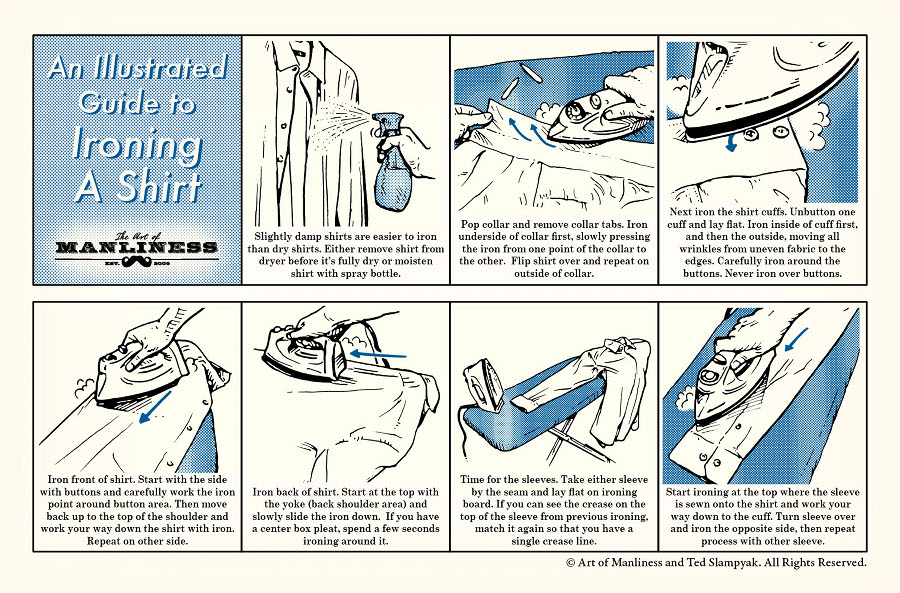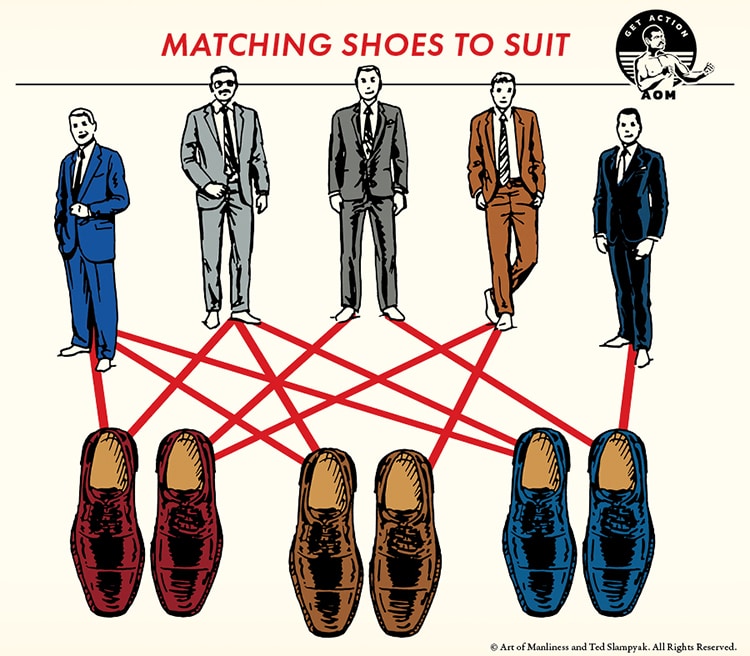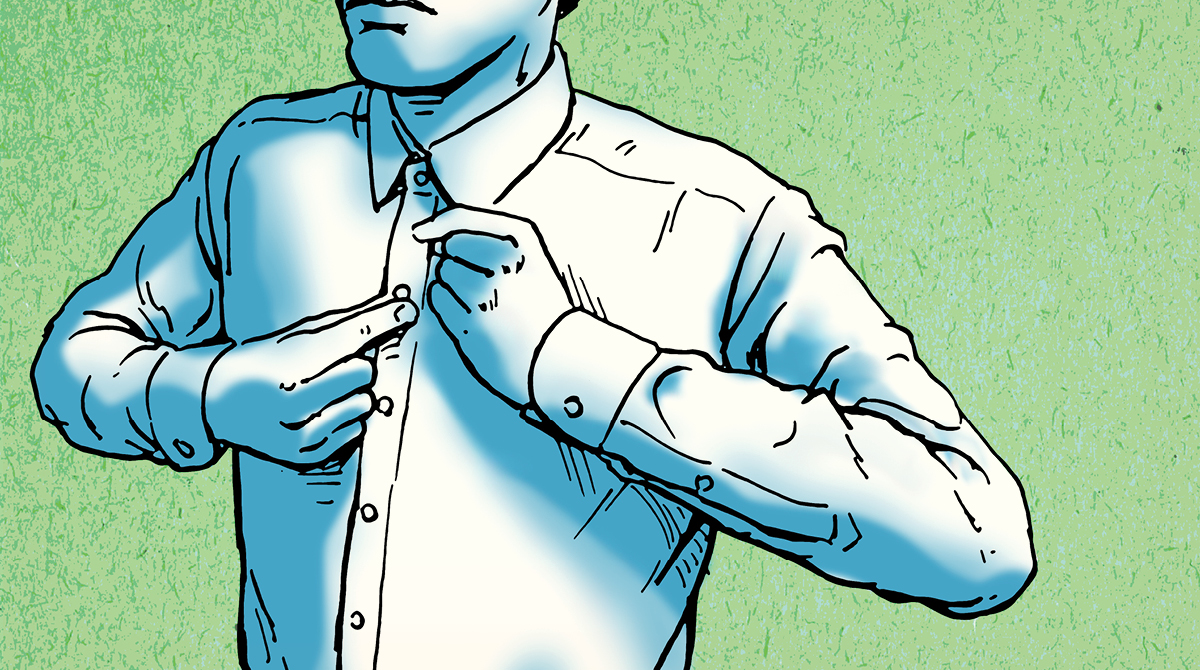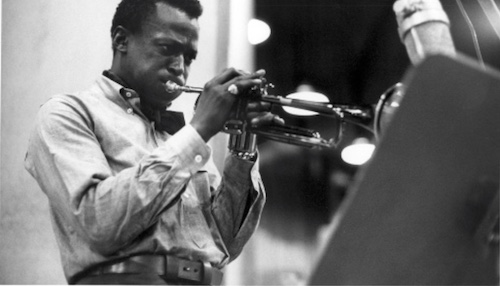
A man’s dress shirt can elegantly frame his face during a presentation and later absorb his perspiration during a tough round of questioning. It can play a supporting role by enhancing his sport jacket or it can stand alone and be the centerpiece of his outfit. The dress shirt ranges in price from the $9.99 Wal-Mart polyester special to over $600 for a name brand custom shirt. But why would you want to read an entire article about dress shirts?
Because details matter. In any given day we only speak with a small percentage of the people we see; the shirt you wear, in the absence of a jacket, is the most powerful signal you are using to non-verbally communicate with those around you. Your shirt, whether you like it or not, is speaking for you; make sure it’s saying what you intend.
What is a Dress Shirt
A proper dress shirt is a button-up shirt with a collar, long sleeves, and wrist cuffs. It is usually made from a cotton fabric woven and dyed into various, non-obtrusive patterns and colors. By altering these characteristics, a dress shirt can either send the message its wearer is ready for sport or ready to meet the president.
Dress Shirt Fit
Most men wear dress shirts that do not fit them properly. The problem is that ready made garments are made to fit many; as a result, they fit no one perfectly. We all compromise somewhere if a shirt fits us in the neck it fails us in the sleeve length; if it fits well in the sleeves, it billows out around the stomach. So the fit I’ll describe here is generally only achievable on a custom shirt or one that’s close to fitting and then tailored by a skilled hand.
A well fitted dress shirt should first and foremost be comfortable; this is different for every man. Larger men are usually complimented by a looser fit while petite and thin men are complimented by a more form cut. In general, though, a shirt should:
- Allow two fingers in the collar when buttoned.
- Be tight enough around the wrist so that the cuffs must be unbuttoned to slip them off.
- Have long enough sleeves so that you can raise your arms like wings and not pull the cuffs down the forearm; they should be short enough so that you don’t have more than 1 inch of fabric bunching near the cuff when your arms hang.
- Shoulder points that extend to the end of the shoulder and no farther.
- Have room in the chest and waist to pinch out 1-3 inches of fabric (depending on fit desired).
Dress Shirt Fabric
Cotton. The undisputed king of shirt fabrics, cotton has been the choice of those in the know for centuries. A finely woven cotton fabric exhibits all the properties a man could want from a garment worn close to the body, good heat & moisture conduction, durability, smoothness, and the ability to take shape when ironed.
Man-Made Fibers. Although they do not exhibit the same desirable properties as cotton, man made fibers have made a huge impact on the shirt scene due to their ability to do an acceptable job at a rock bottom price. Often wrinkle and stain resistant, these fibers have and will continue to play a major role in menswear. Although I recommend staying away from shirts with more than 50% man made fiber, for the budget minded, they may be a viable alternative.
Silk. A luxury fabric easily recognizable because of its sheen and light drape, it is not recommended for most as, the maintenance costs are high and long term durability low. But that’s just my opinion!
Dress Shirt Color

White – The most common shirt color; historically it has dominated the scene and was initially the only choice for a gentleman. The lack of color on a man’s collar and cuffs signified he did not have to do dirty work; colored shirts were looked upon with suspicion as it was assumed they were colored to hide stains. To this day, white still reigns as the most formal color, and its popularity has safely placed it among the iconic garments a man can wear. Where ever you may be, a man can safely assume a white shirt will never be out of place.
Blue – Blue’s dominance has more to do with its ability to compliment most men’s complexions rather than heritage. The popularity of blue exploded in the United States as more and more off-the-rack manufactures looked for colors and patterns that would sell. Today the color firmly holds a place as a safe alternative to white. And unfortunately, this is often the extent of the variety found in a man’s dress shirt collection.
Other Colors – Pink, gold, lavender, off-white, forest green, and even red, just a few of the multitude of colors available to the man who is willing to walk a different path. Whether these colors dominate the dress shirt, or highlight the pattern woven into it, they can compliment every complexion out there. And with less than 10% of the shirt wearing population even dabbling into these shades, the man who masters wearing them can easily set himself apart in a room of like dressed men.
Patterns
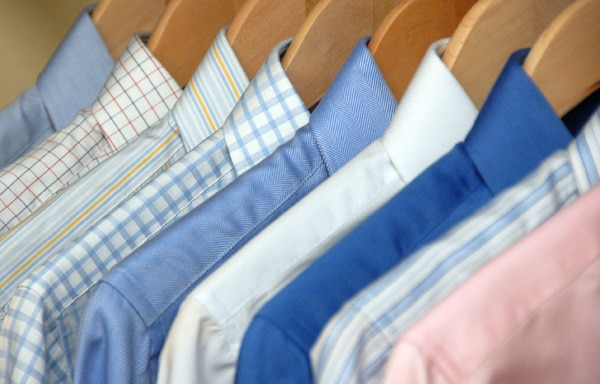
Solid – The simplest and most formal pattern, yet the most versatile. A solid shirt’s defers attention away from the color (unless it is gaudy) and instead helps a man better display the style and fit of his garment. And solid doesn’t always mean solid; different weaves can slyly give the impression of monotony from a distance only to reveal their true nature up close. A solid white poplin fabric has a very different look and feel from a solid white twill or herringbone.
Stripe – Most of us can’t go wrong with a classic blue on white, but consider adding certain accent colors such as red or pink to liven up the hues in the face. This pattern looks especially good with a solid colored suit.
Check – Historically the purpose of the check was to signify a wearer’s background. Today, most men are intimidated to wear such a pattern with a suit as they think it will appear overpowering. It won’t, as long as you remember not to mix like patterns; a checked shirt with a solid suit and striped tie are a great combination. However, it is the least formal pattern and should be worn carefully in business on the US East Coast and abroad.
The Shirt Collar
The purpose of a shirt collar is to properly balance and frame a man’s face. It’s the most visible part of a shirt when wearing a jacket and because of it’s proximity to the face, plays a very large role in determining the formality and use of the shirt. For this article we will only talk about turndown collars and its two major variants, the point and spread.
 Point Collars – The most common collar style seen in the US is the point collar; found on 95% of off-the-rack dress shirts, it is cut so that the collar points are reasonably close together with the collar angle being at or less than 60 degrees. The advantage of this collar style is that longer, more closely set points tend to draw the eye down which elongates the face. Unfortunately, most off-the-rack point collars seek the middle ground and do not have a small enough angle or long enough points to reap the full rewards of this effect.
Point Collars – The most common collar style seen in the US is the point collar; found on 95% of off-the-rack dress shirts, it is cut so that the collar points are reasonably close together with the collar angle being at or less than 60 degrees. The advantage of this collar style is that longer, more closely set points tend to draw the eye down which elongates the face. Unfortunately, most off-the-rack point collars seek the middle ground and do not have a small enough angle or long enough points to reap the full rewards of this effect.
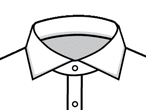 Spread Collars – The second style is the spread or “cutaway” collar. These collars have the points “cut away” thus the name, revealing more of the upper shirt area; typically we see these collars with angles greater than 90 degrees. Spread collars are excellent for the gentleman with a medium to long shaped face, as they do the opposite of the point and spread out a man’s features.
Spread Collars – The second style is the spread or “cutaway” collar. These collars have the points “cut away” thus the name, revealing more of the upper shirt area; typically we see these collars with angles greater than 90 degrees. Spread collars are excellent for the gentleman with a medium to long shaped face, as they do the opposite of the point and spread out a man’s features.
Shirt Cuffs
Besides the collar, the shirt’s cuffs are the only visible parts of a shirt when a jacket is worn; they are divided into two types, button (casual to formal) and French (formal).
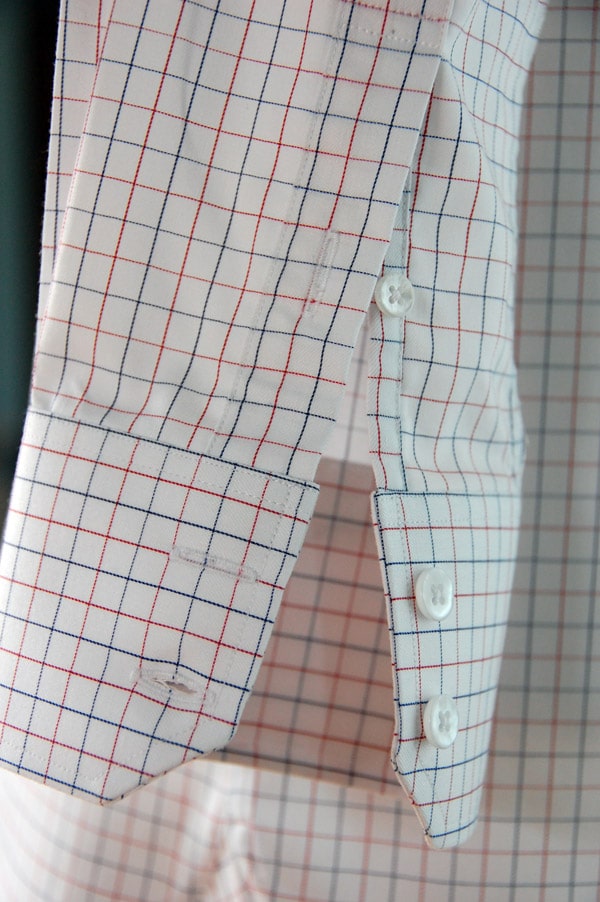
Button Cuffs – Button cuffs are single cuffs which wrap around the arm and are buttoned into place. These are the cuffs most commonly found on ready made shirts. Button cuffs may have a single button or may be adjustable, with two buttons side-by-side. Some have two buttonholes and two vertical buttons- a more formal option often called the “barrel cuff.” Button cuffs may also have a small button on the sleeve, between the cuff and the end of the cuff opening, intended to prevent the area from opening and exposing the gentleman’s wrist.
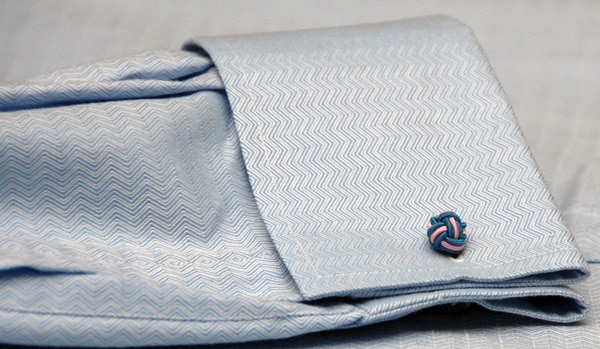
French Cuffs – French cuffs are the most formal option, yet are perfectly appropriate for daily wear in many industries such as finance. The French cuff is a double cuff, folded back and fastened with cufflinks to create a distinctive and distinguished appearance. Cufflinks must always be worn – though there are more subtle options available, such as fabric knots – so the gentleman must be prepared to keep a reasonable selection on hand.
Dress Shirt Buttons

Most buttons today are made of plastic, a suitable material for the job as it is inexpensive and fairly strong. However, if a low quality resin is used, the base of your buttons will crack, and they may break within a year. An eloquent alternative to plastic is Mother of Pearl. Not actually pearl, these buttons are made from shell and are so hard that they can break needles. They are only found on higher end clothing today because of their cost and tendency to disintegrate over time when exposed to harsh detergents.
Closing Comments
This article could go on; we didn’t even get into monograms, pockets, split yokes, the placket, gussets, pattern matching, collar stays, and back style. For those interested in more, please visit A Tailored Suit’s Style Guide or the resources we listed in The Art of Manliness’s best online style links.
Matching a Tie With Your Dress Shirt
Matching your dress shirt with a tie and suit can be tricky business. Here’s a guide on how to match your tie with a dress shirt and suit.


